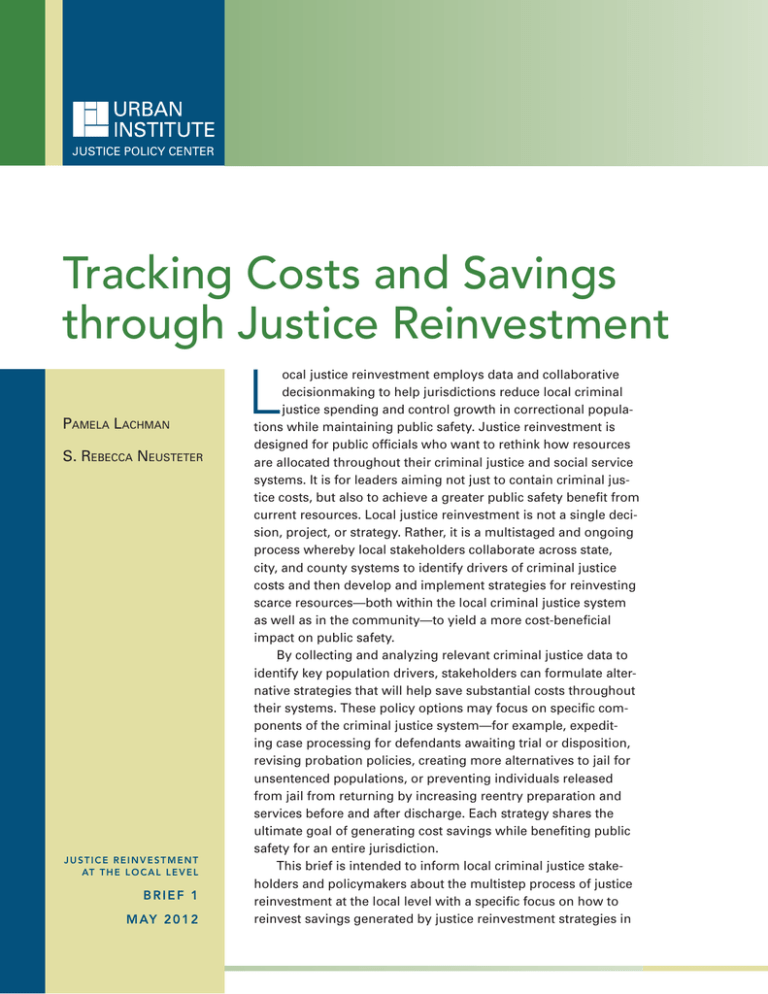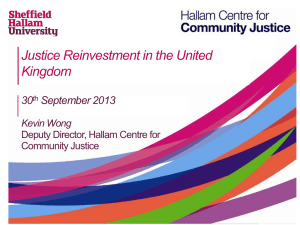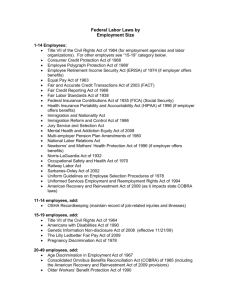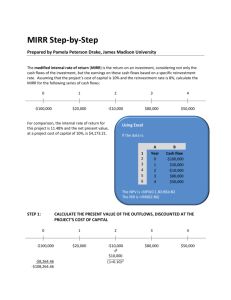L Tracking Costs and Savings through Justice Reinvestment 1
advertisement

Tracking Costs and Savings through Justice Reinvestment 1 Justice Policy Center Tracking Costs and Savings through Justice Reinvestment Pamela Lachman S. Rebecca Neusteter Justice Reinvestment at t h e L o c a l L e v e l Brief 1 MAY 2 0 1 2 L ocal justice reinvestment employs data and collaborative decisionmaking to help jurisdictions reduce local criminal justice spending and control growth in correctional populations while maintaining public safety. Justice reinvestment is designed for public officials who want to rethink how resources are allocated throughout their criminal justice and social service systems. It is for leaders aiming not just to contain criminal justice costs, but also to achieve a greater public safety benefit from current resources. Local justice reinvestment is not a single decision, project, or strategy. Rather, it is a multistaged and ongoing process whereby local stakeholders collaborate across state, city, and county systems to identify drivers of criminal justice costs and then develop and implement strategies for reinvesting scarce resources—both within the local criminal justice system as well as in the community—to yield a more cost-beneficial impact on public safety. By collecting and analyzing relevant criminal justice data to identify key population drivers, stakeholders can formulate alternative strategies that will help save substantial costs throughout their systems. These policy options may focus on specific components of the criminal justice system—for example, expediting case processing for defendants awaiting trial or disposition, revising probation policies, creating more alternatives to jail for unsentenced populations, or preventing individuals released from jail from returning by increasing reentry preparation and services before and after discharge. Each strategy shares the ultimate goal of generating cost savings while benefiting public safety for an entire jurisdiction. This brief is intended to inform local criminal justice stakeholders and policymakers about the multistep process of justice reinvestment at the local level with a specific focus on how to reinvest savings generated by justice reinvestment strategies in 2 Tracking Costs and Savings through Justice Reinvestment a manner that supports the jurisdiction’s public safety goals. To implement justice reinvestment successfully, local leaders must collaborate throughout each stage to identify how their jurisdiction currently expends its criminal justice resources and to determine what interventions can best enhance public safety while saving financial resources.1 This brief also provides guidance on how stakeholders can conduct a comprehensive assessment of local criminal justice spending, how they should target their reinvestment efforts, and how they can make the most of the savings achieved through the justice reinvestment process. The Local Justice Reinvestment Model The local justice reinvestment model incorporates five key steps: (1) collecting and analyzing data to identify key criminal justice population Figure 1. Local Justice Reinvestment Model STEP 1 Collect and Analyze Criminal Justice Data STEP 5 Implement and Assess Justice Reinvestment Strategies Interagency Strategic Planning STEP 4 Document Savings and Public Safety Impact STEP 2 Identify Cost-Saving Public Safety Strategies STEP 3 Implement Cost-Saving Public Safety Strategies INCREASED PUBLIC SAFETY AND REDUCED COST drivers; (2) developing and implementing alternative strategies to enhance public safety and reduce costs; (3) implementing these strategies; (4) documenting costs and potential savings; and (5) assessing the impact of reinvestment strategies (see figure 1). Each component of the local justice reinvestment model relies upon interagency strategic planning, which must be institutionalized in the locality and involve key stakeholders both within and outside of the criminal justice system. Stakeholders must coordinate new and existing efforts; focus on sharing information among agencies, including providing access between data systems; and routinely track and evaluate the jurisdiction’s progress on justice reinvestment activities.2 The data stakeholders collect and analyze are derived from the stages in the criminal justice process in which agencies, policies, practices, and individuals influence the local corrections population: arrest, pretrial, case processing, sentencing, discharge, and community supervision.3 In all of these stages, agencies experience problems and costs associated with population increases; however, these challenges also offer opportunities to improve efficiencies and savings. Documenting Costs and Demonstrating Savings Generating and measuring savings are necessary precursors to the actual process of reinvesting. In determining what policies to implement, stakeholders must first estimate the savings associated with potential policy changes. This requires stakeholders to determine which parts of the system (e.g., police, jail, community supervision) will be affected and whether those changes apply to everyone involved in the criminal justice system or to a specific subset of that population. Moreover, the stakeholder group must be able to break down the costs of each system interaction. Tracking Costs and Savings through Justice Reinvestment Take, for example, a county whose data analysis revealed that a disproportionate share of criminal justice resources were spent on substance-abusing individuals cycling in and out of the jail on public nuisance charges while using other local social services at a disproportionately high rate. After analyzing the data, determining the needs associated with the population, and researching potential strategies to address this problem, county stakeholders decided to increase their treatment resources as the primary strategy to address this population. Even though treatment costs are high, they can quickly become self-sustaining if the county is able to redirect resources previously spent on the substance-abusing population. A key component of projecting potential savings is being able to track use of a particular resource. If stakeholders want to target a specific population, such as individuals repeatedly booked into jail, they need to know how often those individuals are booked into jail in a given time period, and then quantify the costs associated with arresting, charging, and booking those individuals during that same time period. They must also consider inmates’ length of stay, a figure that can be found by calculating the consumption of jail bed days or the average length of stay for the given population, and determine whether the population is large enough to account for actual costs in agencies’ budgets (e.g., a treatment pod in jail). These costs may fall into different agencies’ budgets and may even overlap jurisdictions—for example, in many localities the city government pays costs associated with arresting individuals the county books and houses in the local jail. Jurisdictions must also consider that there are different ways to measure costs in a system. For example, a jail facility—whose actual costs are based primarily on unit costs rather than per capita costs—may need to reduce its average daily population by 50 people before closing a dormitory or reducing a food contract. While it may be unrealistic for a jurisdiction to close a jail facility, operating costs could be reduced by decreasing jail bed day consumption (e.g., a reduction of 100 jail bed days sustained over one year could represent a duty post).4 Tracking Populations across Systems Justice reinvestment also has cost implications for agencies outside of the criminal justice system. Many populations that interact with the criminal justice system (e.g., drug users, chronic inebriants, and homeless individuals) also interact with local social service agencies and consume just as many, if not more, of these resources than other members of the public. In most jurisdictions, the daily cost of emergency room visits, hospitalization, mental health services, or drug treatment far exceeds criminal justice system costs, yet many of the same people directly interact with all of these systems. The decisions that criminal justice stakeholders make about individuals—particularly whether to arrest or incarcerate—have direct implications for social service and health care stakeholders. For example, incarceration can have serious negative consequences for individuals with a mental illness; it can disrupt their treatment and rehabilitation, which in turn places an additional resource burden on the health care system that attempts to treat them. As illustrated in table 1, John Doe consumes significant local services. While the cost of a single jail booking in this jurisdiction might only be $200, John Doe was booked 10 times in the past 12 months, bringing his individual booking and jail bed day cost to the jail to $2,000 in a single year. In addition, his case processing cost is spread out across four separate agencies—the courts, the prosecutor’s office, the public defender’s office, and community supervision (which houses the county’s pretrial services department). John Doe is also absorbing significant human services resources such as temporary shelter, emergency room visits, and treatment bed days; his treatment 3 4 Tracking Costs and Savings through Justice Reinvestment Table 1. Documenting Individual Yearly Costs Name Police John Doe $10,000 Jail $2,000 Courts Prosecutor’s office Public defender’s office Community supervision $6,500 $1,000 $1,000 $200 costs are particularly high since he is admitted to treatment facilities regularly and requires psychotropic drugs to manage his Axis I mental health diagnosis. Although John Doe consumes resources throughout the entire jurisdiction, criminal justice and non-criminal-justice actors are likely unaware of how much he collectively costs the jurisdiction. This is why individuallevel analyses of cost consumption can be particularly beneficial to jurisdictions’ justice reinvestment processes. While conducting such analyses on all individuals who enter and exit these systems is not feasible, costs can be quantified across a random sample or cohort of “high-consuming” individuals (e.g., those booked into jail more than a certain number of times in a year).5 A jurisdiction needs to identify many John Does (i.e., a large enough population) before agencies can develop programs and realize savings. The above example underscores the importance of coordinating efforts to track and document costs and services provided across agencies for unique individuals within a single jurisdiction. In some cases, one agency might assume most of the costs associated with the target population, but another agency might bear the brunt of the intervention. In the John Doe example, he uses more human services resources than criminal justice resources, but the best system response to his needs might be funded by the criminal justice system through, for example, a supervised diversion program. Moreover, the criminal justice agency incurring the cost of the intervention could be a state agency; this is particularly true of programs operated by state community supervision and courts. Therefore, it is important to realize savings as an entire jurisdiction (county and city) Social Services Housing $19,000 Hospitals Treatment $250,000 $300,000 Total $589,700 and develop a reinvestment strategy that uses savings to improve public safety. Measuring Savings throughout Jurisdictions As illustrated in figure 2, justice reinvestment can have different effects on county and city budgets, in part because each agency incurs criminal justice costs differently. In addition, depending on the jurisdiction, many costs are entirely or partially covered by the state. In Doe County and Doe City, both the local education agency and court system are funded by the county. In different states, localities’ budgets are structured differently; some city budgets may include education costs, while some courts and community supervision budgets are funded by the state. Despite these differences, in general, cities expend more funds on law enforcement, while counties bear the cost of corrections. Differences in site-specific expenditures and revenue sources are felt throughout the different levels of government, since law enforcement and corrections directly affect each other; how the police choose to arrest and charge a person can determine if that person is booked into jail, and how that person is released from jail can impact whether the person is arrested again. Take, for example, a jurisdiction that chose to implement a policy change in law enforcement by developing a crisis intervention team (CIT), a strategy many jurisdictions have employed in responding effectively to calls involving individuals with a mental illness. While the CIT approach may have led city police officers to arrest fewer people (thus decreasing the costs associated with arresting and Tracking Costs and Savings through Justice Reinvestment 5 Figure 2. Doe County and City Budgets before Local Justice Reinvestment a. County Budget before Local Justice Reinvestment b. City Budget before Local Justice Reinvestment Community supervision 7% Community and economic development 15% General governmental costs 5% Law enforcement 11% Other 15% Courts 22% Corrections 22% Human services 12% Urban development 3% Recreation 10% Law enforcement 66% Human services 6% Figure 3. Doe County and City Budgets after Local Justice Reinvestment a. County Budget after Local Justice Reinvestment b. City Budget after Local Justice Reinvestment Community supervision 14% Courts 17% Community and economic development 21% General governmental costs Law 5% enforcement 7% Other 14% Recreation 10% Corrections 21% Human services 15% Urban development 7% Human services 5% Law enforcement 64% 6 Tracking Costs and Savings through Justice Reinvestment holding individuals with a mental illness), the agency’s budget did not decrease dramatically since it also had to pay for the CIT program. At the county level, the human services and community supervision budgets increased by 3 percent and 7 percent, respectively, because the county devoted more programmatic and training resources to helping the city police department address the needs of the mentally ill. However, because the people targeted by CIT were booked into jail less frequently and had fewer criminal charges filed, the components of the county court and corrections budgets related to processing mentally ill individuals (corrections officer and court officer time, transportation costs, prescription drugs, etc.) decreased by 5 percent and 7 percent, respectively (see figure 3). To quantify these changes, jurisdictions must closely monitor all spending by each agency and by individuals involved in the various systems. If properly measured, over time it should be clear if resource utilization has changed—whether it has decreased, shifted, or remained the same. However, tracking spending in this way requires extensive commitment from a wide range of stakeholders6 and a detailed plan for measurement.7 The remainder of this brief will focus on where and how such savings may be reinvested. Determining How to Reinvest Because costs and savings can be identified across multiple agencies, key stakeholders must agree where resources will be reinvested. For example, if the strategy the jurisdiction wishes to employ involves shortening the time from arrest to case disposition through reducing continuances or resetting cases, then the judiciary, court administration, defense bar, and prosecutor’s office will likely all need changes to achieve this goal.8 If successful, the strategy will manifest savings across all of these agencies by reducing court costs. Unless the stakeholders responsible for the jail’s budget have agreed to reinvest these savings in the desired strategy, the savings may not be used to sustain the jurisdiction-wide effort. Therefore, all stakeholders must agree upfront how savings will be tracked, as well as what portion of the savings will be reinvested and where. Understanding where resources should be reinvested is the final component of local justice reinvestment. Resources should be reinvested in the community and the criminal justice system in a manner that improves the quality and quantity of services and resources where individuals involved in the local criminal justice system reside. This investment can have a direct impact on public safety, improving outcomes for individuals involved in the criminal justice system, as well as those at risk of becoming involved. Reinvestment in the community can be in the form of improving housing services, increasing the number of treatment beds, ensuring continuity of care, creating more resource centers and alternative-tojail programs, providing victim services, and enhancing the capacity of community-based residential and outpatient programming. Community-based reinvestment can also focus on prevention and diversion strategies, which can have a long-term impact on improving public safety. Reinvestment in the local criminal justice system can occur through implementing screening and assessment procedures, developing substance abuse and mental health treatment services, providing education and job training programs, and establishing prerelease centers or discharge planning measures to enhance reentry success. These tools, programs, and services address the primary drivers of criminal justice costs, which in turn can create more opportunities for reinvestment in the future. Table 2 provides a method for ensuring that justice reinvestment can accomplish this goal. The Getting Started worksheet “Efficiently Utilizing Reinvestment Resources” at the end of this brief describes a step-by-step approach to preparing for a justice reinvestment project. Tracking Costs and Savings through Justice Reinvestment 7 Table 2. Helpful Hints for Efficiently Utilizing Reinvestment Resources Key strategy Purpose of strategy Connection to justice reinvestment model Develop approach specific to population(s) driving local costs Identifying drivers of local criminal justice costs enables stakeholders to track their costs and savings throughout the initiative, allowing stakeholders to identify which reinvestment opportunities will maximize the utility of their limited resources. This data-driven approach is part of the first major phase of local justice reinvestment—collecting and analyzing data to inform strategies that can yield savings throughout the system. Connect effort with existing resources Because justice reinvestment involves a broad group of key stakeholders (both within and outside the criminal justice system), it is possible to identify where the initial changes to policy and practice as well as the overall reinvestment process can build upon existing efforts in the jurisdiction (state, county, and city). Coordination can prevent duplication of efforts and increase the resources available for reinvestment. An ongoing component of local justice reinvestment is interagency strategic planning. This allows key stakeholders to coordinate their efforts both on the front end (in analyzing data and developing policies) and the back end (in reinvesting resources locally). Engage community In order to avoid potential community resistance (e.g., “not in my backyard”), community leaders need to be engaged throughout the justice reinvestment process. This will minimize conflict at project start-up because community leaders and local residents will not be caught off guard regarding how resources are spent in their communities. Engaging key community members throughout the process and assessing the impact of justice reinvestment can help policymakers address the potential pitfalls of community resistance—if there is a clearly documented, data-driven approach that guides policy development, stakeholders will be able to use it as the basis of justifying their decisions. Mapping to Target Reinvestment In the community, reinvestment holds the greatest promise of yielding a significant impact if it is focused on specific “high-stakes” neighborhoods associated with disproportionate criminal justice involvement and spending, as well as disproportionate social service consumption. A data-driven approach is crucial in identifying where most crime occurs, where incarcerated individuals come from and will be released to, and where other criminal justice resources are expended. By mapping crime, incarceration, and release trends, jurisdictions can identify which neighborhoods have the highest incarceration rates, share the greatest concentration of supervised populations, and receive the majority of local jail and prison releases. Counties can also use mapping to compare criminal justice costs to social service expenditures (such as welfare assistance, housing, health care, and education). This process helps local stakeholders better understand community needs and gaps in services that justice reinvestment can address. Figure 4 depicts a map of Travis County, Texas, which shows that the rate of jail releases (as a percentage of the U.S. Census tract population) is highest in the central part of the county. As figure 5 demonstrates, the Census tracts with the most jail releases are the same Census tracts where the median income is 35 percent below the county average. This map indicates that the population interacting with the local criminal justice system overlaps substantially with the county’s more impoverished residents, who also depend greatly on social services. This overlap reinforces how reinvestment can affect communities at multiple levels (not just in the criminal justice arena). Conclusion While adhering to the justice reinvestment model is important, the model itself will not ensure success. Jurisdictions cannot follow prescribed steps, declare victory, and move on. To the contrary, justice reinvestment, particularly its ultimate goal of reinvesting resources in areas that will improve public safety, can only be successful 8 Tracking Costs and Savings through Justice Reinvestment Figure 4. Travis County Jail Releases Number of Returning Jail Detainees per 1,000 Residents 0–15 16–25 26–50 51–100 101–1,000 Source: Travis County Sheriff’s Office FY2010 Releases from Jail. Data extracted by Tonya Mills, Travis County Criminal Justice Planning. Created by Justin Archer, The Urban Institute, 2011. if jurisdictions approach it with an eye toward achieving a tangible and meaningful shift in local decisions about resource allocation and public safety initiatives. Justice reinvestment should be viewed as an iterative process that relies on ongoing strategic planning as its core function. Without the continued commitment of key stakeholders, the justice reinvestment process will not be able to sustain itself over time. This brief has described the process by which stakeholders can examine the populations interacting with their local systems and assess how each agency’s budget may be affected. By doing this, stakeholders can determine the county’s cost drivers and begin a process that allows them to track spending and achieve tangible savings. They can also use data to find where their resources may have the biggest impact—where the need and the opportunity to enhance public safety are greatest. If justice reinvestment is done effectively and with strong leadership, it can produce savings and create a long-term impact on public safety. Additional Resources Justice Reinvestment at the Local Level Brief Series: Data-Driven Decisionmaking for Strategic Justice Reinvestment. http://www. urban.org/url.cfm?ID=412542. Tracking Costs and Savings through Justice Reinvestment Figure 5. Yearly Median Household Income in Travis County Median Household Income No data Under $35,000 $35,001–$50,000 $50,001–$80,000 $80,001–$120,000 Over $120,000 Source: US Census Bureau. Created by Justin Archer, The Urban Institute, 2011. Justice Reinvestment at the Local Level Brief Series: Improving Strategic Planning through Collaborative Bodies. http://www. urban.org/url.cfm?ID=412543. Justice Reinvestment at the Local Level Planning and Implementation Guide: http:// www.urban.org/url.cfm?ID=412233. Notes 1. For more information on justice reinvestment partnerships, see the companion brief by Archer, Neusteter, and Lachman (2012). 2. Again, see Archer, Neusteter, and Lachman (2012) for more details. 3.See the companion brief by Dwyer, Neusteter, and Lachman (2012) for more information on collecting data at key decision points in the criminal justice system. 4. For more information about variables to consider in measuring overall criminal justice costs, see the companion brief by Dwyer, Neusteter, and Lachman (2012). 5. For more information on how jurisdictions may be able to collect and analyze these data, see the companion brief by Dwyer, Neusteter, and Lachman (2012). 6.See Archer, Neusteter, and Lachman (2012). 7.See Dwyer, Neusteter, and Lachman (2012). 8.See Archer, Neusteter, and Lachman (2012). 9 10 Tracking Costs and Savings through Justice Reinvestment References Archer, Justin, S. Rebecca Neusteter, and Pamela Lachman. 2012. “Improving Strategic Planning through Collaborative Bodies.” Justice Reinvestment at the Local Level brief 3. Washington, DC: The Urban Institute. http://www.urban.org/url. cfm?ID=412543.html. Dwyer, Allison M., S. Rebecca Neusteter, and Pamela Lachman. 2012. “Data-Driven Decisionmaking for Strategic Justice Reinvestment.” Justice Reinvestment at the Local Level brief 2. Washington, DC: The Urban Institute. http://www.urban.org/ url.cfm?ID=412542.html. Copyright © May 2012 The views expressed are those of the authors and do not necessarily reflect those of the Urban Institute, its partners, its trustees, or its funders. Permission is granted for reproduction of this document, with attribution to the Urban Institute. Tracking Costs and Savings through Justice Reinvestment 11 Getting Started Worksheet: Efficiently Utilizing Reinvestment Resources This worksheet walks through key elements to have in place for successful justice reinvestment. To determine where your city or county currently falls and what areas require additional effort, answer the following questions of your current criminal justice system. 1. Developing an approach specific to the population(s) driving local costs. Does my jurisdiction have a method of distinguishing the following types of costs? Yes No Marginal costs at the line-item level for each county/city agency Resource use (broken down by day, month, year) Consumption of resources by particular populations See the companion brief “Data-Driven Decisionmaking for Strategic Justice Reinvestment” for more details on collecting these data (Allison M. Dwyer, S. Rebecca Neusteter, and Pamela Lachman, Justice Reinvestment at the Local Level brief 2. Washington, DC: The Urban Institute, 2012. http://www.urban.org/url.cfm?ID=412542). 2. Connecting efforts with existing resources. Does my jurisdiction have a means of tracking how additional resources outside of the criminal justice system (such as the examples below) may address the needs of and/or benefit specific criminal justice populations? Yes No Yes No Child support restitution programs Domestic violence intervention programs Drug treatment programs Social service assistance programs (e.g., food stamps) Mental health treatment services Other 3. Engaging the community. Are the following community representatives involved with the strategic planning process? Advocates for victims Advocates for children of the incarcerated Advocates for the homeless Neighborhood associations Community-based services providers Faith-based organizations See the companion brief “Improving Strategic Planning through Collaborative Bodies” for more details on collecting these data (Justin Archer, S. Rebecca Neusteter, and Pamela Lachman, Justice Reinvestment at the Local Level brief 3. Washington, DC: The Urban Institute, 2012. http://www.urban.org/url.cfm?ID=412543). 12 Tracking Costs and Savings through Justice Reinvestment The Justice Reinvestment Initiative In October 2010, the Bureau of Justice Assistance formalized the Justice Reinvestment Initiative (JRI) to expand prior state and local justice reinvestment work. JRI provides technical assistance and competitive financial support to states, counties, cities, and tribal authorities either currently engaged in justice reinvestment or well positioned to undertake such work. The initiative is structured in two phases: in Phase I sites receive intensive onsite technical assistance to start the justice reinvestment process and in Phase II sites receive targeted technical assistance and are eligible for seed funding to support the implementation of justice reinvestment strategies. For more information about JRI, visit http://www.bja.gov/JRI. Justice Reinvestment at the Local Level (JRLL) was a partnership between the Urban Institute and three local jurisdictions: Alachua County, Florida; Allegheny County, Pennsylvania; and Travis County, Texas. For more information on JRLL, e-mail jrll@urban.org or visit us online at http://justicereinvestment.urban.org. This project was supported by Grant No. 2009-DD-BX-K040 awarded by the Bureau of Justice Assistance. The Bureau of Justice Assistance is a component of the Office of Justice Programs, which also includes the Bureau of Justice Statistics, the National Institute of Justice, the Office of Juvenile Justice and Delinquency Prevention, the Office for Victims of Crime, and the Office of Sex Offender Sentencing, Monitoring, Apprehending, Registering, and Tracking. Points of view or opinions in this document are those of the author and do not necessarily represent the official position or policies of the U.S. Department of Justice.







